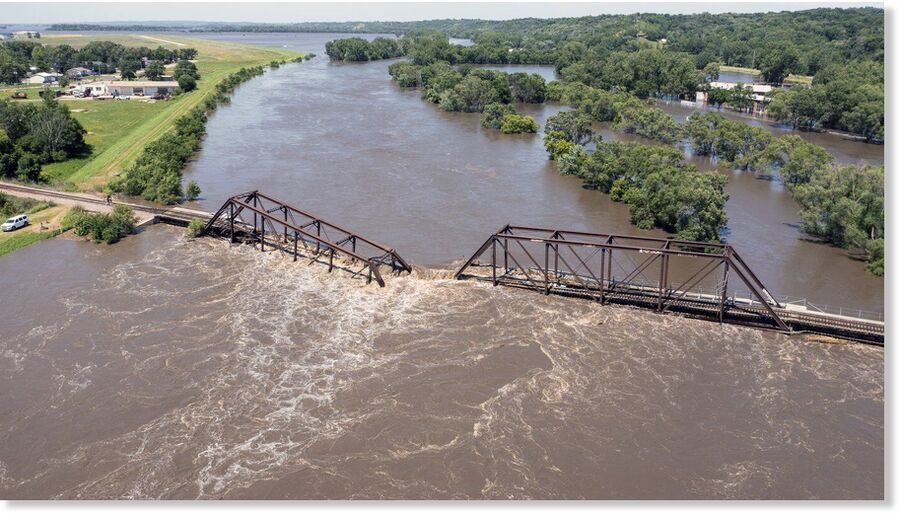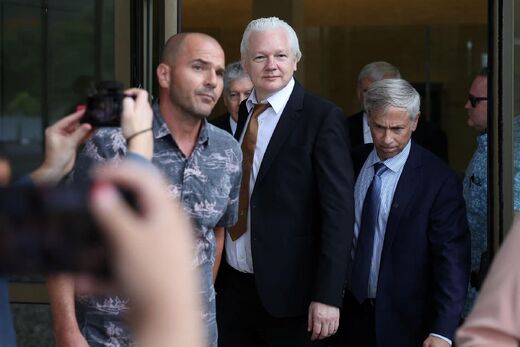
An Illinois man died Saturday while trying to go around a barricade in Spencer, Iowa, Sioux City's KTIV-TV reported Monday.
The Little Sioux River swept his truck away, according to a news release from the Clay County Sheriff's Office provided to the station. Officials found the vehicle in the treeline but weren't able to recover his body until Monday because of dangerous conditions.
At least one person died in South Dakota, Gov. Kristi Noem has said without providing details.
The flooding brought added misery to parts of Iowa, Nebraska, South Dakota and Minnesota during a vast and stubborn heat wave. In some communities hit by flooding, the temperature Monday afternoon approached 100 degrees Fahrenheit (37.7 Celsius).
More than 3 million people live in areas touched by flooding, from Omaha, Nebraska, to St. Paul, Minnesota. Storms dumped huge amounts of rain from Thursday through Saturday, with as much as 18 inches (46 centimeters) falling south of Sioux Falls, South Dakota, according to the National Weather Service.
Places that didn't get as much rain had to contend with the extra water moving downstream. More rain is forecast, and many streams may not crest until later this week as the floodwaters slowly drain down a web of rivers to the Missouri and Mississippi. The Missouri will crest at Omaha on Thursday, said Kevin Low, a weather service hydrologist.
Flooding in the Omaha area Monday was causing Amtrak to use buses to transport passengers temporarily, according to an Amtrak spokesperson.
"I've never had to evacuate my house," Hank Howley, a 71-year-old North Sioux City, South Dakota, resident said as she joined others on a levee of the swollen Big Sioux River, where the railroad bridge collapsed a day earlier. She did not have to evacuate in recent days either, but said: "We're on the highest spot in town. But what good is that when the rest of the town is flooded? It makes me nervous."
The bridge connected North Sioux City, South Dakota, with Sioux City, Iowa, and fell into the Big Sioux River around 11 p.m. Sunday, officials said. Images on local media showed a large span of the steel bridge partially underwater as floodwaters rushed over it.
There were no reports of injuries from the collapse. The bridge's owner, BNSF Railway, had stopped operating it as a precaution during the flooding, spokesperson Kendall Sloan said. The railroad said the bridge was used by only a few trains per day and did not expect rerouting to have a significant impact.
The Big Sioux River stabilized Monday morning at around 45 feet (13.7 meters), over 7 feet (2.1 meters) higher than the previous record, Sioux City Fire Marshal Mark Aesoph said.
In North Sioux City, the South Dakota Department of Transportation built a berm Sunday night across Interstate 29 to stem flooding, temporarily blocking the major route. In other areas where the interstate remained open, water crept toward the road. Howley, who has lived there for 33 years, said she has a growing concern over more frequent severe flooding around I-29.
The flooding has, over the course of days, damaged roads and bridges, shuttered or destroyed businesses, required hospitals and nursing homes to evacuate, and left cities without power or safe drinking water, the governors of Iowa and South Dakota said.
"I just keep thinking about all this stuff I've lost and maybe the little things I could recover that we put up high," said Aiden Engelkes in the northwestern Iowa community of Spencer, which imposed curfews during flooding that surpassed a record set in 1953. "And then I think about where my friends are, because their stuff is also gone."
Over the weekend, teams from Iowa's natural resources department evacuated families with children and a person using a wheelchair from flooded homes, director Kayla Lyon told reporters. Gov. Kim Reynolds said the department conducted 250 water rescues on Saturday.
"At one point we had 22 conservation officers doing water rescues, navigating some pretty nasty current," Lyon said.
(More here)



Comment: See also: Northwest Iowa residents evacuated because of flooding - Gov. Kim Reynolds declares disaster